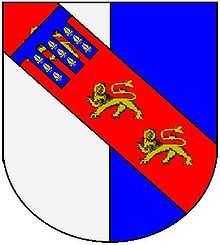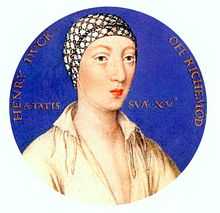Royal bastard

A royal bastard is a child of a reigning monarch born out of wedlock. The king might have a child with a mistress, or the legitimacy of a marriage might be questioned for reasons concerning succession. Notable royal bastards include Henry Fitzroy, son of King Henry VIII of England, and the Duke of Monmouth, son of Charles II. The surname "Fitzroy" means "son of a king" and was used by various illegitimate royals, and by others who claimed to be such. In medieval England, a bastard's coat of arms was marked with a "bend" or "baton sinister."[1]
The stereotypical royal bastard is Edmund in Shakespeare's King Lear, intelligent, but villainous. Edmund tells his legitimate half brother Edgar:
- I must have your land. Our father’s love is to the bastard Edmond
- As to th’ legitimate. Fine word, ‘legitimate’ Well, my legitimate, if this letter speed
- And my invention thrive, Edmond the base
- Shall to the legitimate: I grow, I prosper. Now gods, stand up for bastards!.[2]
Ancient Rome
Unlike medieval royals, the Romans were more concerned with continuity of family name than with bloodline.[3] If a man recognized a child as his, this was accepted by law and the issue of who the biological father was did not arise.[3] If a child was not recognized, it could be exposed or brought up as a slave. Emperor Claudius initially accepted a girl as his daughter, but later rejected her and had her exposed.[3] Emperors often adopted their successors. There are no recorded examples of aristocrats in classical times accusing other aristocrats of being illegitimate, as was common among in later periods.[3]
Caesarion was the bastard of Julius Caesar by Cleopatra.

England
In Anglo-Saxon times, the descendants of kings were called aethelings, whether legitimate or not. When the office of king became vacant, a Witan would meet to name a successor from among the aelthings. Papal legates visited the court of Offa of Mercia in 786 and decreed that an English king "must not be begotten in adultery or incest" and that "he who was not born of a legitimate marriage" could not succeed to the throne.[4] It is likely that there was no succession rule regarding bastards prior to this decree. All the same, Athelstan, bastard of Edward the Elder, succeeded as king in 924. English monarch William the Conqueror was also a bastard.
Gervais of Blois, a bastard of King Stephen, was abbot of Westminter.[5] Richard III justified his accession to the throne by claiming that the children of Edward IV were the product of an invalid marriage.
Henry I
Henry I had 21 to 25 bastards, including Robert, 1st Earl of Gloucester, Maud FitzRoy (wife of Conan III, Duke of Brittany), Constance or Maud FitzRoy, Mabel FitzRoy, Alice FitzRoy, Gilbert FitzRoy, Emma.[6] "It might be permissible to wonder how it was that Henry I managed to keep track of all his illegitimate children, but there is no doubt that he did so," wrote historian Given-Wilson.[5]
Henry VIII
Henry VIII had one acknowledged royal bastard, Henry FitzRoy, 1st Duke of Richmond and Somerset. As he had many mistresses, six other people are also put forward by historians as possibly being Henry's illegitimate children, including the mercenary Thomas Stukley, the poet Richard Edwardes and two of Mary Boleyn's children.
Charles II
Charles II fathered at least 20 illegitimate children, of which he acknowledged 14.[7] The most famous of these was the Duke of Monmouth, his son by Lucy Walter. After Charles' death, Monmouth led a rebellion against his uncle James II.
When Nell Gwynn brought her first child to Charles, she told it, 'Come hither you little Bastard and speak to your father!'.[8]
- "Nay, Nellie, do not call the child such a name," said the king.
- "Your majesty has given me no other name by which I may call him."
Charles then named the child "Beauclerk" and bestowed the title "Earl of Burford."

Illegitimate children of Charles II
By Lucy Walter (c.1630–1658)
- James Scott, 1st Duke of Monmouth (1649–1685). Ancestor of Sarah, Duchess of York.
By Elizabeth Boyle, Viscountess Shannon (1622–1680)
- Charlotte Paston, Countess of Yarmouth (1650–1684),
- Charles FitzCharles, 1st Earl of Plymouth (1657–1680), known as "Don Carlo", created Earl of Plymouth (1675)
- Catherine FitzCharles (born 1658; she either died young or became a nun at Dunkirk)[9]
By Barbara Palmer, 1st Duchess of Cleveland (1641–1709)
- Anne Lennard, Countess of Sussex (1661–1722). She may have been the daughter of Roger Palmer, but Charles accepted her.[10]
- Charles FitzRoy, 2nd Duke of Cleveland (1662–1730).
- Henry FitzRoy, 1st Duke of Grafton (1663–1690). The 7-greats-grandfather of Diana, Princess of Wales
- Charlotte Lee, Countess of Lichfield (1664–1717).
- George FitzRoy, 1st Duke of Northumberland (1665–1716).
- Lady Barbara FitzRoy (1672–1737) – She was probably the child of the Duke of Marlborough.[11] She was never acknowledged by Charles.[12]
By Nell Gwyn (1650–1687)
- Charles Beauclerk, 1st Duke of St Albans (1670–1726)
- James, Lord Beauclerk (1671–1680)
By Louise de Kérouaille, Duchess of Portsmouth (1649–1734),
- Charles Lennox, 1st Duke of Richmond and Lennox (1672–1723). Ancestor of Diana, Princess of Wales; Camilla, Duchess of Cornwall; and Sarah, Duchess of York.
By Moll Davis, courtesan and actress of repute[13]
- Lady Mary Tudor (1673–1726).
Illegitimate children of James II
James II had 13 bastards,[14]
United Kingdom
William IV had 11 bastards.[15] William's illegitimate children used the surname "FitzClarence" because he was duke of Clarence.[15] When Victoria became queen, she banned royal bastards from court as "ghosts best forgotten."[15] Since then, the issue has been shrouded in secrecy and any subsequent bastards have gone unacknowledged.[15]
Bastard pride
In recent years, there has been significant public attention given to the modern descendants of illegitimate British royals. Referring to such people as "royal bastards" has become common, although they are generally neither royal nor bastards. For example, the term is used by the hereditary society "Descendants of the Illegitimate Sons and Daughters of the Kings of Britain."[16] The society offered to admit Queen Elizabeth II, noting that she is a descendent of Henry I's illegitimate daughter Constance and has two other illegitimate ancestors. PBS produced a show called Lost Royals that tracked down such descendants.[17]
France
Anthony, bastard of Burgundy was the natural son of Philip the Good of Burgundy. He was known as le grand bâtard (the great bastard). He was legitimized by King Charles VIII in 1485.
Louis XIV
Louis XIV had many mistresses and bastards. Madame de Maintenon was their governess.[18] "The bastards", as they were called, were compared to mules, unnatural hybrids who should not reproduce. "No issue should come of such species," the king once said.[19] But Louis nonetheless found appropriate spouses for his bastards.[19] As bastards were considered impure, their mothers might attempt to purify them through pious behavior.[19] Louise de La Vallière had six children by Louis XIV, including Marie Anne de Bourbon (1666–1739) and Louis de Bourbon (1667–1683). She repented by joining a Carmelite convent. There she wore a belt of iron spikes that cut into her flesh.[19]
Church leaders denounced Madame de Montespan, Louis' best-known mistress, who had seven children by him. In 1675, Father Lécuyer refused to give her absolution.[20] "Is this the Madame that scandalises all France?" he asked. "Go abandon your shocking life and then come throw yourself at the feet of the ministers of Jesus Christ." The king's efforts to legitimize his bastards showed his, "Olympian disdain for public opinion," according to one modern author.[18] The edict of Marly, issued in July 1714, granted two of Louis' sons by Montespan the right to succeed to the French throne.[21] This hugely unpopular decision led to a political crisis called the "bastard distortion" in 1714-1715.[21] It was reversed by the Parliament of Paris in July 1717, after Louis had died.[21]
Belgium
A book published in February 2011 claimed that Albert II of Belgium has an illegitimate half-sister named Ingeborg Verdun, the daughter of King Leopold III and Austrian-Belgian ice skater Liselotte Landbeck.[22]
Spain
In 2003, Leandro Ruiz Moragas, an illegitimate son of King Alfonso XIII gained the right to call himself a prince.[23]
References
- ↑ Given-Wilson, Chris, and Alice Curteis, The Royal Bastards of Medieval England (1995), pp. 52, 48-49.
- ↑ Shakespeare, William, King Lear
- ↑ 3.0 3.1 3.2 3.3 Catharine Edwards, The Politics of Immorality in Ancient Rome, p. 51-52.
- ↑ John Cannon, Ralph Griffiths, The Oxford Illustrated History of the British, p. 37
- ↑ 5.0 5.1 Chris Given-Wilson, Alice Curteis, The royal bastards of medieval England (1984).
- ↑ Kathleen Thompson, "Affairs of State: The Illegitimate Children of Henry I". Journal of Medieval History Volume 29, Issue 2, June 2003, Pages 129-151.
- ↑ George Edward Cokayne, The complete peerage of England, Scotland, Ireland, Great Britain, Vol. 6, p. 706.
- ↑ The Museum of foreign literature, science, and art, Volume 14 edited by Robert Walsh, Eliakim Littell, John Jay Smith
- ↑ Hutton, p.125
- ↑ Cokayne, George E.; Revised and enlarged by Gibbs, Vicary; Edited by Doubleday, H. A., Warrand, D., and de Walden, Lord Howard (1926), "Appendix F. Bastards of Charles II", The Complete Peerage, London: St. Catherine Press, Volume VI, pp.706–708
- ↑ Miller, Charles II pp.97, 123
- ↑ Fraser, Antonia (1979), King Charles II, London: Weidenfeld and Nicolson, ISBN 0-297-77571-5, pp.65 and 286.
- ↑ Fraser, p.287
- ↑ David Hilliam, Kings, queens, bones, and bastards: who's who in the English monarchy from Egbert to Elizabeth II
- ↑ 15.0 15.1 15.2 15.3 Roger Powell, MA & Peter Beauclerk Dewar, Royal Bastards (2008).
- ↑ Descendants of the Illegitimate Sons and Daughters of the Kings of Britain
- ↑ Royal Bastards
- ↑ 18.0 18.1 Cruttwell, Maud, Madame de Maintenon, p. 67.
- ↑ 19.0 19.1 19.2 19.3 Emmanuel Le Roy Ladurie, Jean-François Fitou, Saint-Simon and the court of Louis XIV, p. 106
- ↑ A lust for virtue: Louis XIV's attack on sin in seventeenth-century France By Philip F. Riley
- ↑ 21.0 21.1 21.2 Emmanuel Le Roy Ladurie, The Ancien Régime: a history of France, 1610-1774, p. 284.
- ↑ Leo Van Audenhaege, From Küssnacht to Argenteuil"
- ↑ "Spain's 'royal bastard' becomes prince"
Further reading
- Roger Powell and Peter Beauclerk, Royal Bastards: Illegitimate Children of the British Royal Family (2008)
- Chris Given-Wilson and Alice Curteis, The Royal Bastards of Medieval England (1995)
- Peter Beauclerk-Dewar and Roger Powell Right Royal Bastards: The Fruits of Passion (2007)
- Anthony J. Camp, Royal Mistresses and Bastards Fact and Fiction 1714-1936 (2007)